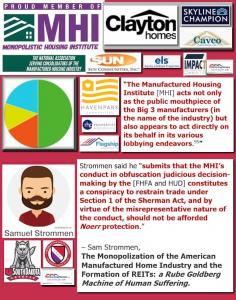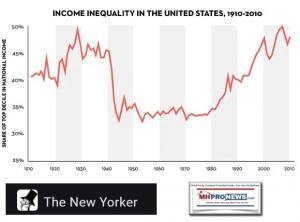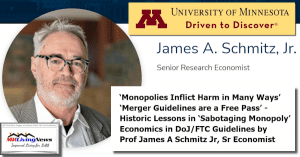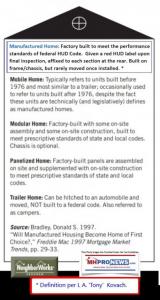‘Monopolies Inflict Harm In Many Ways’ ‘Merger Guidelines Are Free Pass’ – Historic Lessons in ‘Sabotaging Monopoly’ Economics to DoJ-FTC by Prof. James A. “Jim” Schmitz Jr. Sr. Economist, to MHLivingNews.com

Knudson Law’s Strommen Manufactured Housing Institute Quote: MHI Mouth Piece of Big 3 Manufacturers Clayton Homes, Skyline Champion, Cavco Industries, Restraint of Trade Charged, MHI Should Not Get NOERR protection.

New Yorker’s Wealth Inequality Chart covers years 1910-2010 reflecting an interesting pattern. The Middle Class, working class, and retirees do better when monopoly power is in greater check. If federal and/or state officials fail to check monopoly power others suffer.
Affordable manufactured homes ‘sabotaged’ by builders, HUD per Univ of MN Schmitz's DoJ/FTC Expert Statement-‘Exploit Members of Own Group’ per MHLivingNews.com
KISSIMMEE, FL, UNITED STATES, May 4, 2022 /EINPresswire.com/ — A new evidence-packed report, analysis, and commentary on MHLivingNews.com unpacks an important presentation by Professor James A. Schmitz Jr. provided to the Department of Justice (DoJ) and Federal Trade Commission (FTC) on the hot-button issues of monopolies and mergers. The report is a general commentary on an issue that impacts several parts of the U.S. economy and general public. But Schmitz specifically mentions factory-built housing, which includes manufactured homes regulated by the U.S. Department of Housing and Urban Development (HUD).
“Jim” Schmitz Jr.’s comments letter to the Department of Justice (DoJ) include the following observations:
“monopolies inflict harm in many ways. These include:
A. Monopolies sabotage and destroy markets. They typically destroy substitutes for their products, often those that would be purchased by low-income households;
B. Monopolies also use their weapons to manipulate and sabotage public institutions for their own gains;
C. Monopolies not only inflict harm on “outsiders,” that is, those not in the monopoly. In Thurman Arnold’s (1943) words, monopolies “exploit members of their own group."
Note that when monopolies sabotage substitutes for their product (as in A), they are, again, blocking “outsiders.” When they exploit members of their own group (as in C), they are sabotaging “insiders.”
Also note that I have not mentioned prices. The harm caused by monopoly prices were often a secondary concern for our forebears, as they knew these other actions of monopolies (A-C) could be much more destructive.”
MHLivingNews requested and obtained Schmitz’s comments. The University of Minnesota economist's research in several respects compliments the previously published study provided by Samuel “Sam” Strommen with Knudson Law. Strommen’s legal thesis includes evidence-based allegations of the type of market manipulation in manufactured housing described as alleged “felony” antitrust violations involving some of the manufactured housing industry’s largest firms.
That report was entitled: "Strommen “Felony” “Conspiracy” Case-“Monopolization” of Affordable Manufactured Housing and Manufactured Home Communities “Rube Goldberg Machine of Human Suffering” by Manufactured Housing Institute Firms – Knudson Law," and is found at the link below.
What Strommen documented seems to fit what Schmitz described as: "Monopolies not only inflict harm on “outsiders,” that is, those not in the monopoly. In Thurman Arnold’s (1943) words, monopolies “exploit members of their own group" in as much as Manufactured Housing Institute (MHI) members are accused of undermining competitors.
Schmitz in his capacity as a senior economist at the Minneapolis Federal Reserve is among those experts and researchers who has repeatedly looked into the effects of ‘sabotaging monopoly’ power on manufactured homes and prefabricated housing as an alternative to more costly conventional housing. While that's only lightly referenced in this specific document addressed to federal officials, Schmitz's report is presented on MHLivingNews because it presents a historic context for the importance of enforcing antitrust laws in the U.S. In a related article, MHLivingNews recently provided a report and commentary linked below that presented antitrust enforcement as a possible options for manufactured home community residents resisting "predatory" tactics by certain ‘consolidators’ of manufactured home communities.
Against that backdrop, Schmitz’s thesis to federal officials sets the stage for his complete presentation to the DOJ/FTC on the topic of monopoly power and why he argues that public officials should resist such monopolistic formation in their merger guidelines.
As Prof. Schmitz explained it: "Competition and mergers are, of course, closely related, two sides of the same coin. Theory about one is theory about the other (as is evidence). This claim about competition, then, is also a claim about mergers. Since mergers reduce competition, they reduce productivity."
He said: "There is a breakdown in DOJ/FTC handling of mergers." "The left hand (i.e., when writing the guidelines) doesn’t know what the right hand (i.e., when expressing the basic premise of DOJ/FTC policy) is doing. There is a failure – I call it a conceptual-failure."
"By not discussing the evidence on the negative impact of mergers on productivity, these guidelines do not provide an important and meaningful check on mergers."
Schmitz's well footnoted document includes 5 sections. "In Section 1, I briefly review the DOJ/FTC basic premise that competition spurs productivity. Section 2 discusses the efficiency section of the guidelines. The complete focus of the section is on how mergers may increase productivity. The conceptual-failure is clear."
The MHLivingNews report quotes Schmitz saying, "there is an abundance of theory and evidence for the basic premise. Some of this was developed by our forbears, such as, of course, Adam Smith, and including names such as Frank Fetter, Jacob Viner, Henry Simons, and Thurman Arnold (and is discussed in Section 3). One of the greatest periods of advance in our knowledge of monopoly, in fact, was during Thurman Arnold’s tenure at the DOJ (1938-43). Arnold had a great knowledge of monopolies when he started. Over the course of the next five years, he and his colleagues developed a tremendous body of new theory and evidence. Though our forebears knowledge was developed in part at the DOJ during the late 1930s and early 1940s, the DOJ/FTC have ignored this evidence (beginning in perhaps the 1950s, but certainly by the 1960s. See discussion of Williamson (1968) below)."
To tee up section 4 of his thesis, Schmitz cited the "Arnold-Simons model of monopoly (Schmitz, 2020). In this model, monopolies, and mergers, lead to declines in productivity for many reasons.
There is another body of theory and evidence developed on monopoly over [the] last few decades (and is discussed in Section 4). In this “recent” literature, Thomas Holmes and I developed a model of monopoly based on the behavior of monopolies we studied in the 1980s (Holmes and Schmitz (1995, 2001)). Our model turns out to be very similar the Arnold-Simons model of monopoly. Monopoly, mergers, lead to low productivity."
Potential investors in affordable housing or manufactured homes should take note. Schmitz, an expert, directly challenges several of the basic presumptions about mergers and increased productivity. In as much as competition is good for productivity, mergers would routinely – he reasoned and evidenced – decrease productivity.
"Sections 3 and 4 therefore show that, indeed, competition spurs productivity. Both these bodies of theory and evidence provide a sound footing for the basic premise…But valuable lessons are learned by pursuing the question: How did this conceptual failure emerge or develop? I discuss this in section 5."
Schmitz explained that: "In a speech, Russell Damtoft (2013, p.1) argued: “competition is what makes free markets work, and that in turn is the source of American productivity, innovation, competitiveness, and national prosperity.”…
“Competition usually spurs firms to achieve efficiencies internally.”
So, the guidelines begin by establishing the basic premise – what we expect. The first sentence could also have been written as
“Because mergers reduce competition in industries, it usually reduces efficiency within the merging firms.”
Following this first sentence, we find a mild surprise: The second sentence is:
“Nevertheless, a primary benefit of mergers to the economy is their potential to generate significant efficiencies and thus enhance the merged firm’s ability and incentive to compete, which may result in lower prices, improved quality, enhanced service, or new products.”
Schmitz then contends that the system at DOJ/FTC as it has been operating for years are giving a 'free pass' to more mergers.
"Whereas we expect the vast majority of the section to be why mergers might reduce productivity, with a small side for why there might be exceptions, instead the entire section is about exceptions. The horizontal merger guidelines as written are letting mergers through the review process without important checks on them. The merger guidelines are in effect giving free passes to mergers that should be challenged. The free passes are baked-into the guidelines."
While every section of the report is useful if not essential to the thesis, the senior economist's section on the history of antitrust or anti-monopoly thinking is among the most interesting.
"3. Forebears’ Theory and Evidence on Monopoly
Our forebears developed a very large body of theory and evidence on monopoly, and how it harmed productivity. In fact, Adam Smith likely knew more about monopoly than anyone ever has. Smith’s Wealth of Nations (WON) is many things, and has many parts, but it was first and foremost an attack on monopoly."…"The birth of modern economics, then, as the publication of WON is sometimes referred, was the product of Adam Smith’s great disdain for monopoly (and one of its offspring, mercantilism)."
He hones the evidence of the historic knowledge Schmitz has for years in previous research, often in concert with others, aimed to breathe new life into the need for more antitrust action.
"Here is a description of the Arnold-Simons model of monopoly. Monopolies are organizations formed by groups of individuals to enrich themselves. They make significant investments of time and other resources to help build the monopoly. They develop formidable concentrations of power. Monopolies develop many weapons as they build power. One “weapon,” or strategy, is to make alliances with other similarly situated groups (i.e., other monopolies).
In the model, monopolies inflict harm in many ways. These include: A. Monopolies sabotage and destroy markets. They typically destroy substitutes for their products, often those that would be purchased by low-income households; B. Monopolies also use their weapons to manipulate and sabotage public institutions for their own gains; C. Monopolies not only inflict harm on “outsiders,” that is, those not in the monopoly. In Thurman Arnold’s (1943) words, monopolies “exploit members of their own group.”
Note that when monopolies sabotage substitutes for their product (as in A), they are, again, blocking “outsiders.” When they exploit members of their own group (as in C), they are sabotaging “insiders.”
Also note that I have not mentioned prices. The harm caused by monopoly prices were often a secondary concern for our forebears, as they knew these other actions of monopolies (A-C) could be much more destructive."
…Note that when monopolies sabotage substitutes for their product (as in A), they are, again, blocking “outsiders.” When they exploit members of their own group (as in C), they are sabotaging “insiders.”
Also note that I have not mentioned prices. The harm caused by monopoly prices were often a secondary concern for our forebears, as they knew these other actions of monopolies (A-C) could be much more destructive.
How Do Monopolies accomplish actions A and B?
As I said, monopolies develop many weapons. Here is Wendell Berge, the head of DOJ antitrust following Arnold: “The weapons of monopoly are as numerous as they are artful and varied. It is for this reason that monopoly conditions have often grown up almost unnoticed by the public until one day it is suddenly realized that an industry is no longer competitive but is governed by an economic oligarchy able to crush all competition…”
From the editorial vantagepoint of MHLivingNews, one of the strongest elements of Schmitz in his current and prior research on this topic is precisely the understanding of the "weapons" used by monopolists.
Not only are options or "choices" in housing – or other parts of the economy – limited when competition is limited. But so too are employment options.
Fewer employment options can then be seen as a supply and demand influenced issue. When a concentration of businesses (i.e.: more mergers, more monopolization) occurs, the wealth of the top members of society goes up. When there is more options and less concentration of big business power, then economic equality expands. Note that during the years Schmitz asserted that the DOJ and FTC were more muscular in their antitrust enforcement and in minimizing mergers, there was also greater middle-class wealth. See the graphic from the New Yorker as evidence of that pattern.
Schmitz quotes Smith on "weapons (or tactics, or strategies) of monopoly: “… to attempt to reduce the army would be as dangerous as it has now become to attempt to diminish in any respect the monopoly which our manufacturers have obtained against us. This monopoly has so much increased the number of some particular tribes of them, that, like an overgrown standing army, they have become formidable to the government, and upon many occasions intimidate the legislature.” He sums that up in modern terms by saying that monopolists "Make alliances with the government."
Those alliances can be with lawmakers as well as regulators. Schmitz might have used here terms such as "the Iron Triangle" or "revolving door" which have been well documented by other researchers. That noted, Schmitz has done yeoman work pulling together the important history that has largely been lost which explains the backdrop to many modern American problems. Lobbyists, for instance, are a symptom or 'tool' of would-be or actual monopolists.
Citing "Thurman Arnold, roughly 175 years after Smith: Monopolies are organizations that “… enter into politics using money and economic coercion to maintain themselves in power, making alliances with other powerful groups against the interests of consumers and independent producers. In short, they will become a sort of independent state within a state, making treaties and alliances, expanding their power by waging industrial war, dealing on equal terms with the executive and legislative branches of the government, and defying governmental authority if necessary with the self-righteousness of an independent sovereign.""
Here Schmitz sprinkles references to factory-built housing that would include manufactured homes, which he names in other research. "Our forebears had extensive evidence for monopolies sabotaging substitute products. This came from their great knowledge of history, detailed studies of monopolies and, of course, intimate knowledge of the current economies of their day."
"From at least 1920, the U.S. traditional construction industry began successfully sabotaging U.S. factory-production of homes. The forces lined-up against the factory-housing industry were like a “perfect storm.” There were many groups that were organized as “individual” monopolies that were opposed to factory-production of homes, including labor unions, building inspectors, associations of building contractors, materials suppliers, local political groups that benefited from support of these monopolies, and more. In addition, these individual monopolies made alliances to oppose producers of factory-built homes. The distribution of power between these alliances and factory-producers was, of course, very skewed. The alliances successfully squashed the development of factory-built housing.
When Thurman Arnold was at DOJ, he and his colleagues attempted to protect the factory housing industry."
"When Arnold left DOJ, he kept working for the protection of factory-built housing. This is from Arnold (1947): “Why can’t we have houses like Fords [i.e., automobiles]? For a long time, we have been hearing about mass production of marvelously efficient postwar dream houses, all manufactured in one place and distributed like Fords. Yet nothing is happening.
The low-cost mass production house has bogged down. Why?"
Schmitz and Strommen made the point that manufactured homes are undermined by 'sabotaging monopoly' power. Strommen observed, the Manufactured Housing Improvement Act (MHIA) of 2000 and its "enhanced preemption" authority over local zoning could spur a solution based on existing law. Schmitz's reveals how breaking up monopoly power could spur more new housing rapidly too. The Manufactured Housing Assoc for Regulatory Reform (MHARR) recently stressed this too at this link here. ##
L. A. "Tony" Kovach
MHLivingNews.com
+ +1 832-689-1729
email us here
Visit us on social media:
Facebook
Twitter
LinkedIn
Other



